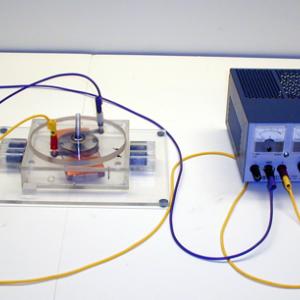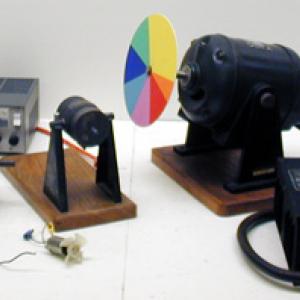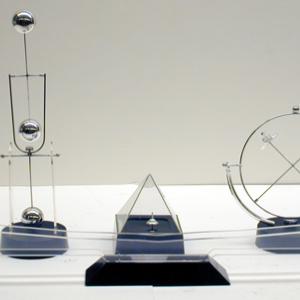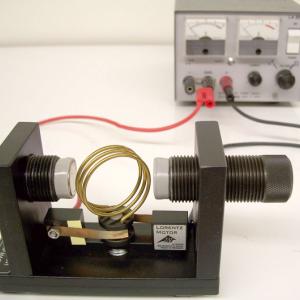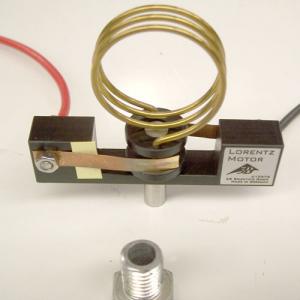College of Liberal Arts & Sciences
5K40.10 - DC Motors
Hook the Plexiglas motor up as shown. Place on an overhead projector. Use no more than 15 Volts. Be sure to align the arrows drawn on the motor to get correct armature and point placement. The other set of arrows is where to place the rotating coils so that the motor will start when the voltage is applied. This motor may also be hooked to one of the lecture bench galvanometers to show that it can also be a generator. The large motor is hooked to its power supply and may be operated at variable rpms. The smaller motors may be run off any DC power source as long as the voltage rating of each motor is not exceeded.
The small homemade motor is an easy one to use when trying to show motor direction verses magnetic field direction. It can also be used to show rotation verses current direction.
The toy mobiles are nothing more than backwards motors. In these motors the coil is the stationary part and the magnets are the rotating or moving part.
The "Lorentz Motor" attachment is designed for use in the Pasco adjustable magnets. First screw the bolt insert into the magnet from the bottom up. Then place the shaft of the attachment into the bolt insert and adjust the poles of the magnet so that they are about 3 mm from the coil when it is spinning. Set the power supply for 12 Volts. When it is running the coil will draw about 3 Amps.
- Huaihua Zhang, Jinglu Zhang, William J. Browne, "A Hands-On Investigation of Simple Motors", TPT, Vol. 63, #2, Feb. 2025, p. 126.
- Yuki Matsumoto, Kei Sakaki, and Mamoru Sakaki, "Development of a New Method for Assembling a Bipolar DC Motor as a Teaching Material", TPT, Vol. 55, #5, May 2017, p. 293.
- Seok-In Hong, Jung-In Choi, and Seok-Cheol Hong, "Making a Simple Self-Starting Electric Motor", TPT, Vol. 47, #4, Apr. 2009, p. 204.
- David Kagan, "Upright Homopolar Motor", TPT, Vol. 43, #2, Feb. 2005, p. 68.
- Christopher Chiaverina, "The Simplest Motor?", TPT, Vol. 42, #9, Dec. 2004, p. 553.
- Steve Dail, "Overheating Motor Demo", TPT, Vol. 41, #8, Nov. 2003, p. 444.
- Paul Hewitt, "Figuring Physics: Overheating Motor", TPT, Vol. 41, #5, May 2003, p. 303.
- Arthur F. Klittnick and Malcolm J. Rickard, "Mystery Motor Demystified", TPT, Vol. 39, #3, Mar. 2001, p. 174.
- H. Richard Crane, "How Things Work: Mini-Motors Driven by Waves", TPT, Vol. 32, #6, Sept. 1994, p. 360.
- David Lindquist and Walter Connolly, "Apparatus for Teaching Physics: The Simplest Electric Motor?", TPT, Vol. 24, #3, Mar. 1986, p. 167.
- William Shanks and Rudy Keil, "A Cheaper Motor", TPT, Vol. 23, #5, May 1985, p. 308.
- Scott Welty, William Blunk, and Earl Zwicker, "Doing Physics: The Electric Motor Challenge", TPT, Vol. 23, #3, Mar. 1985, p. 172.
- Jerry Entrikin and David Griffiths, "Simple Self‐Lubricated Electric Motor for Elementary Physics Lab", TPT, Vol. 21, #6, Sept. 1983, p. 398.
- R. Barrett, Randy Frey, and Ray Kipe, "Improvement On The Simple Homemade Motor", TPT, Vol. 16, #7, Oct. 1978, p. 505.
- Thomas B. Greenslade, Jr., "Page-Type Motor", AJP, Vol. 93, #1, Jan. 2025, p. 57.
- Thomas B. Greenslade, Jr., "Page-Type Electric Motor", AJP, Vol. 89, #12, Dec. 2021, p. 1102.
- H. Gruenberg, "The Ball Bearing as a Motor", AJP, Vol. 46, #12, Dec. 1978, p. 1213.
- Andy Graham, "Building a Simple DC Motor", PIRA Newsletter, Vol. 3, #17, Jan. 1990, p. 5.
- "B-075. Duracell DC Motor & Nail Motor", DICK and RAE Physics Demo Notebook, 1993.
- G. D. Freier and F. J. Anderson, "Eq-5", A Demonstration Handbook for Physics.
- G. D. Freier and F. J. Anderson, "Eq-4", A Demonstration Handbook for Physics.
- G. D. Freier and F. J. Anderson, "Ei-19", A Demonstration Handbook for Physics.
- George M. Hopkins, "Simple Electric Motor", Experimental Science, p. 497.
- A. D. Bulman, "A Simple Electric Motor", Model-Making for Physics, p. 118.
- Charles Vivian, "Make a Simple Electric Motor", Science Experiments & Amusements For Children, p. 48.
- Pat Murphy, Ellen Macaulay, and the staff of the Exploratorium, "Stripped-Down Motor", Exploratopia, p. 334.
- Borislaw Bilash II, David Maiullo, "Build a Simple DC Motor", A Demo a Day: A Year of Physics Demonstrations, p. 308.
- "A Quickly Made Toy Electric Motor", The Boy Mechanic Makes Toys, p. 54.
- Cy Tymoney, "Sneaky Motor", Sneakiest Uses for Everyday Things, p. 56.
- Yaakov Kraftmakher, "3.1. Rotating Magnetic Field", Experiments and Demonstrations in Physics, ISBN 981-256-602-3, p. 141.
- Yaakov Kraftmakher, "1.13. Lenz's Rule", Experiments and Demonstrations in Physics, ISBN 981-256-602-3, p. 48.
- Simon Quellen Field, "A Motor with Two Coils", Gonzo Gizmos, p. 43 - 44.
- Simon Quellen Field, "A Quickie Electric Motor", Gonzo Gizmos, p. 35 - 39.
- R.D. Edge, "The Simplest Electric Motor", String & Sticky Tape Experiments, p. 12.1.
- Robert Ehrlich, "M.7. The World's Simplest Motor", Turning the World Inside Out and 174 Other Simple Physics Demonstrations, p. 162 - 163.
- "Stripped Down Motor", The Exploratorium Science Snackbook, p. 97-1.
- "Simple Electric Motor", Physics From the Junk Drawer, 3rd Edition, The Science House, North Carolina State University, p. 41.
- Rudolf F. Graf, "Building a Simple Motor", Safe and Simple Electrical Experiments, p. 67.
- Herb Strongin, “Building the Shoestring Motor“, Science on a Shoestring, p. 180.
Disclaimer: These demonstrations are provided only for illustrative use by persons affiliated with The University of Iowa and only under the direction of a trained instructor or physicist. The University of Iowa is not responsible for demonstrations performed by those using their own equipment or who choose to use this reference material for their own purpose. The demonstrations included here are within the public domain and can be found in materials contained in libraries, bookstores, and through electronic sources. Performing all or any portion of any of these demonstrations, with or without revisions not depicted here entails inherent risks. These risks include, without limitation, bodily injury (and possibly death), including risks to health that may be temporary or permanent and that may exacerbate a pre-existing medical condition; and property loss or damage. Anyone performing any part of these demonstrations, even with revisions, knowingly and voluntarily assumes all risks associated with them.
